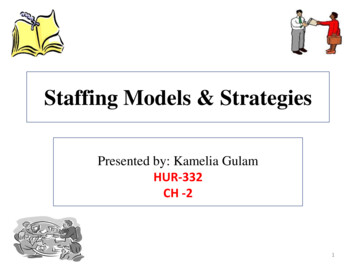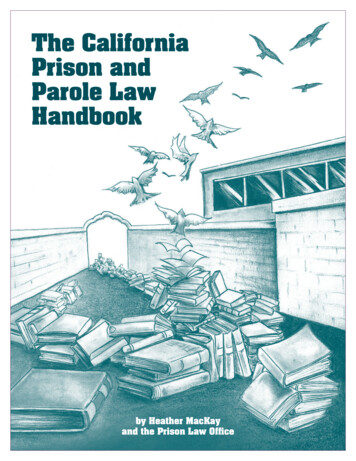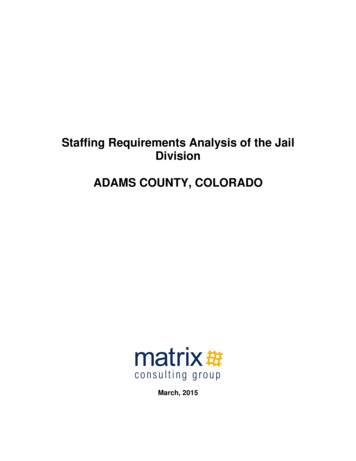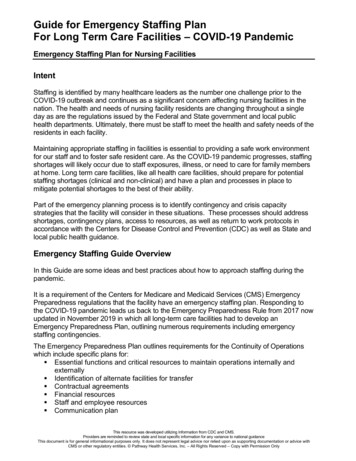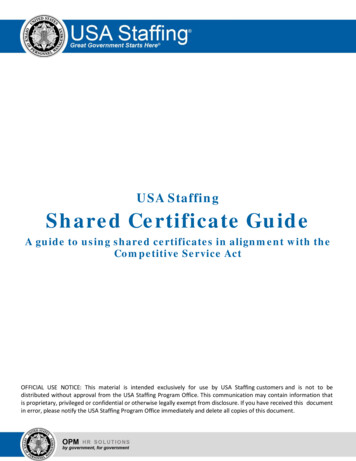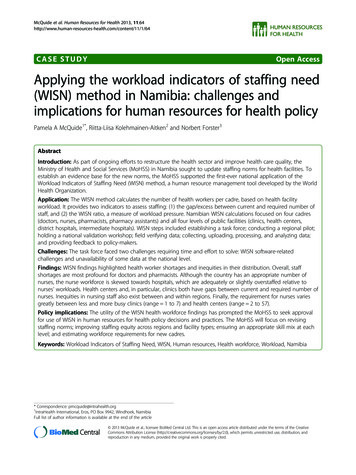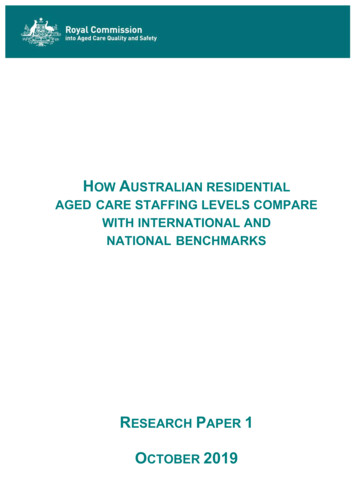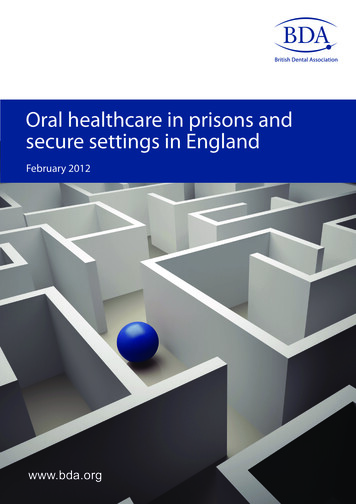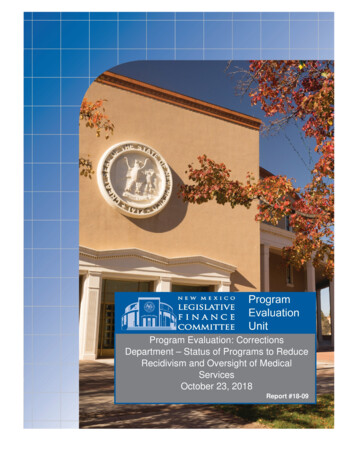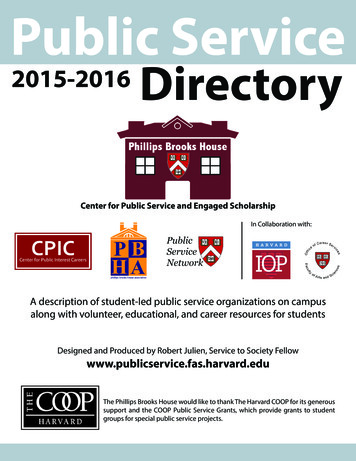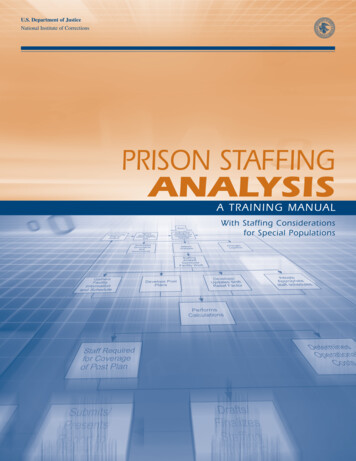
Transcription
U.S. Department of JusticeNational Institute of CorrectionsPRISON STAFFINGANALYSISA T R A I N I N G M AN U ALWith Staffing Considerationsfor Special Populations
U.S. Department of JusticeNational Institute of Corrections320 First Street, NWWashington, DC 20534Morris L. ThigpenDirectorThomas J. BeauclairDeputy DirectorBeLinda P. WatsonChief, Prisons DivisionNational Institute of Correctionswww.nicic.gov
PRISON STAFFINGANALYSISA T R A I N I N G M AN U ALWith Staffing Considerationsfor Special PopulationsCAMILLE GRAHAM CAMPWITH CONTRIBUTIONS FROMPATRICIA L. HARDYMANROBERT MAYGEORGE M. CAMPDECEMBER 2008NIC Accession Number 022667
This document was prepared under cooperative agreement number 03P25GIY5 from the National Institute ofCorrections, U.S. Department of Justice. Points of view or opinions stated in this document are those of theauthors and do not necessarily represent the official position or policies of the U.S. Department of Justice.
CONTENTSForeword . . . . . . . . . . . . . . . . . . . . . . . . . . . . . . . . . . . . . . . . . . . . . . . . . . . . . . . viiPreface . . . . . . . . . . . . . . . . . . . . . . . . . . . . . . . . . . . . . . . . . . . . . . . . . . . . . . . . . ixAcknowledgments . . . . . . . . . . . . . . . . . . . . . . . . . . . . . . . . . . . . . . . . . . . . . . . xiiiIntroduction: Correctional Staffing Issues . . . . . . . . . . . . . . . . . . . . . . . . . . . . . . xvPart 1. Laying the FoundationChapter 1. Security Staff Deployment Policy . . . . . . . . . . . . . . . . . . . . . . . . . . . . 3Chapter 2. Two Models for Managing the Security Staffing Function . . . . . . . . . 7Chapter 3. Agency Staffing Unit . . . . . . . . . . . . . . . . . . . . . . . . . . . . . . . . . . . . . 11Chapter 4. Basic Tasks of a Staffing Analysis . . . . . . . . . . . . . . . . . . . . . . . . . . . 17Chapter 5. Orchestrating the Staffing Analysis . . . . . . . . . . . . . . . . . . . . . . . . . . 21Part 2. Conducting the Staffing AnalysisChapter 6. Agency and Facility Characteristics That Influence Staffing . . . . . . . 29Chapter 7. Operations and Activities Schedules That Influence Staffing . . . . . . 35Chapter 8. Developing the Shift Relief Factor . . . . . . . . . . . . . . . . . . . . . . . . . . 39Chapter 9. Security Post Planning . . . . . . . . . . . . . . . . . . . . . . . . . . . . . . . . . . . . 49Chapter 10. Special Guidelines for Evaluating Housing Units . . . . . . . . . . . . . . 67Chapter 11. The Impact of Staff Scheduling on Staffing. . . . . . . . . . . . . . . . . . . 85Chapter 12. Staffing Calculations . . . . . . . . . . . . . . . . . . . . . . . . . . . . . . . . . . . . 91Chapter 13. Developing a Staffing Report . . . . . . . . . . . . . . . . . . . . . . . . . . . . . . 95Chapter 14. Implementing Recommendations and Monitoring Results . . . . . . 103Part 3. Special Guidelines and ConsiderationsChapter 15. Staffing Considerations for Women’s Correctional Facilities . . . . 109Chapter 16. Staffing Considerations for Medical and Mental Health Units . . . 121 iii
C O N T E N T SGlossary . . . . . . . . . . . . . . . . . . . . . . . . . . . . . . . . . . . . . . . . . . . . . . . . . . . 131Bibliography . . . . . . . . . . . . . . . . . . . . . . . . . . . . . . . . . . . . . . . . . . . . . . . 143AppendixesAppendix A. Security Staffing for Prisons: Results ofFour Nationwide Inventories . . . . . . . . . . . . . . . . . . . . . . . . . . . . . . . . . . . . 151Appendix B. Blank Forms . . . . . . . . . . . . . . . . . . . . . . . . . . . . . . . . . . . . . . . . . 207Appendix C. Sample Description of a Department of Correctionsand Its Facilities . . . . . . . . . . . . . . . . . . . . . . . . . . . . . . . . . . . . . . . . . . . . . . 223List of ExhibitsExhibit 1. Sample Assignment and Scheduling Procedure: Daily Roster . . . . . . . 5Exhibit 2. Model Agency Staffing Function . . . . . . . . . . . . . . . . . . . . . . . . . . . . . 8Exhibit 3. Staffing Analysis Process . . . . . . . . . . . . . . . . . . . . . . . . . . . . . . . . . 18Exhibit 4. Example of Form A: Daily Activities for Facility . . . . . . . . . . . . . . . 37Exhibit 5. Example of Form B: Shift Relief Factor Based onNet Annual Work Hours . . . . . . . . . . . . . . . . . . . . . . . . . . . . . . . . . . . . . . . . . 44Exhibit 6. Example of Form C: Shift Relief Factor Based on Days . . . . . . . . . 47Exhibit 7. Example of Form D: Post Evaluation and Planning Instrument,Part 1, Current Post Plan . . . . . . . . . . . . . . . . . . . . . . . . . . . . . . . . . . . . . . . . 54Exhibit 8. Example of Form D: Post Evaluation and Planning Instrument,Part 2, Recommended Post Plan . . . . . . . . . . . . . . . . . . . . . . . . . . . . . . . . . . 55Exhibit 9. Examples of Form E: Recommended Post Modification . . . . . . . . . 56Exhibit 10. Schematic Design of Two Adjacent Units Joined by aControl Room and Hallway . . . . . . . . . . . . . . . . . . . . . . . . . . . . . . . . . . . . . . 78Exhibit 11. Schematic Design of Four Units Surrounding a FoyerWith a Central Control Room . . . . . . . . . . . . . . . . . . . . . . . . . . . . . . . . . . . . 79Exhibit 12. Descriptive Statistics for Alternative Work Schedules . . . . . . . . . . 88Exhibit 13. Example of Form F: Total Staff Required andTotal Cost by Security Rank . . . . . . . . . . . . . . . . . . . . . . . . . . . . . . . . . . . . . 92Exhibit 14. Views on the Medical and Mental Health Needs ofFemale Inmates and the Effect of These Needs onStaffing Levels in Women’s Institutions . . . . . . . . . . . . . . . . . . . . . . . . . . . . 112Exhibit 15. Views on the Needs of Pregnant Inmates and theEffect of These Needs on Staffing Levels . . . . . . . . . . . . . . . . . . . . . . . . . . 114iv
CONTENTSExhibit 16. Views on the Family-Related Needs of Female Inmatesand the Effect of These Needs on Staffing Levels . . . . . . . . . . . . . . . . . . . . 115Exhibit 17. Views on Differences Between Security Staff Duties inWomen’s Facilities and Those in Men’s Facilities . . . . . . . . . . . . . . . . . . . . 117Exhibit 18. Views on the Implications of Cross-Gender Supervision forFemale Inmates . . . . . . . . . . . . . . . . . . . . . . . . . . . . . . . . . . . . . . . . . . . . . . 118Exhibit 19. Expectations of Security Staff in Medical andMental Health Units . . . . . . . . . . . . . . . . . . . . . . . . . . . . . . . . . . . . . . . . . . . 123Exhibit 20. Views on Indicators of Insufficient Security Staffing . . . . . . . . . . 125Exhibit 21. Views on the Importance of Security Posting Factors inSpecial Population Units . . . . . . . . . . . . . . . . . . . . . . . . . . . . . . . . . . . . . . . 127 v
FOREWORDCorrectional staffing and workforce issues have been at the forefront of topics ad dressed by the National Institute of Corrections (NIC) for a number of years. Oneway that NIC helps correctional administrators and officials address these issuesis to make informative analyses and training materials available to correctionalprofessionals so they may better understand effective staffing practices.Staffing issues have become more critical in the face of reductions in state rev enues and pressure from labor organizations and the courts to provide additionalstaff to supervise and manage prisoners, particularly those with special needs.Prison administrators have been searching for precise methods to deploy staff ap propriately, effectively, and economically.NIC’s Staffing Analysis Workbook for Jails, now in its second edition, has provenvaluable to jail administrators for years. Numerous prison administrators havealso used this workbook and participated in the Institute’s seminar on prison staff ing analysis. Prison Staffing Analysis: A Training Manual With Staffing Consid erations for Special Populations makes use of the concepts and constructs of theworkbook and is informed by a number of articles and supplementary materialsfrom the staffing analysis seminar.The unique character of this training manual, however, is attributable to research.The manual benefits from the responses of correctional agencies to four nationalsurveys that sought information about staffing analysis in general, staffing ofmedical units and facilities, staffing of mental health units and facilities, and staff ing of facilities for women. Consequently, the manual’s discussions of the staffinganalysis process take current practices into account.The manual is also enriched by the experiences and best practices of represen tatives from exemplary and diverse staffing analysis programs. As a result, itincludes practical staffing considerations for women’s facilities and for units thathouse special populations such as inmates who are chronically ill or disabled andinmates who need residential mental health care. v ii
F O R E W O R DPrison Staffing Analysis presents achievable models for establishing a staffingfunction at both the agency and the facility levels. It demonstrates a thoroughstaffing analysis process built on sound policy and procedure and structuredanalytical methods. The manual also offers detailed guidelines for developingand evaluating posts and special guidelines for staffing housing units. It willserve as a substantive training tool and valuable reference for prison administra tors and officials who are responsible for assessing and analyzing their facilities’or systems’ staffing requirements.Morris L. ThigpenDirectorNational Institute of Correctionsv iii
PREFACEModern corrections has come a long way from the days when wardens used theirown rationales for deciding which and how many security staff would work whereand when in their prisons. For many years, the art of staffing was an oral traditionthat evolved in whatever directions were necessary to deal with staff needs andrequests, financial issues, and governmental interest.All that has changed. The growth of the prison population has required morecomplex management of corrections. Decreases in the amount of money availablefor government functions, particularly corrections, have led to increased govern mental scrutiny of staffing requirements because personnel costs make up thelargest portion of operating budgets. External pressure for more staff comes fromcollective bargaining units and prison litigators, while competing governmentalagencies and taxpayer groups think prisons have too many staff. Increasing pres sure for accountability has caused correctional administrators to develop methodsto ensure that staffing complements are planned and managed not only for safety,but also for economy and efficiency.SourcesThis manual adapts the Staffing Analysis Workbook for Jails to the prison environ ment, adding value by drawing from the following additional sources: Materials from NIC’s prison staffing analysis seminar. Nationwide inventories of security staffing analysis practices in facilities and/orunits that house the general population of male offenders and those that housefemale, mentally ill, and chronically ill offenders. Focus group input from staffing analysis and special populations experts. Numerous publications, departmental policies and procedures, and other mate rials pertaining to staffing and populations.FeaturesOf special importance to prison agencies will be the agency perspective foundthroughout this manual as well as fine details and nuances that come from the ix
P R E F A C Eexperience of staffing professionals who have developed, implemented, and im proved exemplary processes. The manual includes the following features: Examination of current staffing issues relevant to correctional agencies. Guidance for correctional managers in setting up security staffing as a systemicand ongoing function of a correctional agency, including: Agency policy. Organizational structure. Data management. Processes for orchestrating staffing analyses at the agency level. Detailed information on how to conduct a staffing analysis, including: Discussion of the characteristics that influence staffing. Instructions on how to calculate shift relief factors for use in evaluating posts. Comprehensive step-by-step instructions and practical application for establish ing and evaluating posts that includes: Checklists and interview questions that will inform recommendations forchanges to and improvements in posts. Tips on writing staffing analysis reports and implementing and monitoringrecommended post changes. Discussion of the implications of custody classifications for the appropriateintensity of inmate supervision. Special focus on the fine points of staffing housing units, including: Detailed, housing-specific considerations. Prototypical housing unit staffing. The economics of staffing housing units. Housing unit diagrams that demonstrate alternative methods of staffing.x The best and current thinking, considerations, practices, and tips with regard tostaffing women’s facilities, mental health units, and units for chronically ill anddisabled inmates. Tips gleaned from practitioners’ best practices. A glossary of terms related to staffing analyses. A comprehensive bibliography. Prototype data collection instruments that agencies can tailor to meet theirunique needs.
P R E FA C EOrganizationThe format of this manual is designed to be suitable for either instructor-ledtraining or self-administered training on both agency- and facility-level staffinganalysis processes. The guidance in these pages will enable an agency staffingadministrator to set up an agency staffing analysis unit and produce a staffinganalysis report for an entire agency.The first five chapters, which form part 1, address the elements that constitute thefoundation for managing prison security staffing from the agency level: a policyfor security staff deployment, the method of managing the staffing function (cen tralized versus decentralized), the responsibilities of an agency staffing unit, thebasic tasks of a staffing analysis, and the preparation necessary for conducting theanalysis.Part 2 of the manual, comprising chapters 6 through 14, covers the process ofconducting a staffing analysis. Chapters 6 and 7 discuss how agency and facilitycharacteristics and operations and activity schedules influence staffing. Chapter 8describes how to develop the shift relief factor for each facility, an important pieceof information used to determine how many staff should be available to cover allposts. Chapter 9 takes readers step by step through the basic post evaluation andplanning process, providing detailed instructions on how analysts should reviewand make recommendations for all posts in a facility. Chapter 10 lays out specialconsiderations that analysts must keep in mind when evaluating housing units,and chapter 11 looks at how staff scheduling affects staffing. Chapters 12 and 13explain how to perform staffing calculations and how to develop staffing reportsbased on the post planning exercise. Chapter 14 concludes part 2 with a discus sion of implementing the recommendations made in the post plan and monitoringresults.The last two chapters in the manual, which comprise part 3, address special con siderations in the staffing of facilities for women (chapter 15) and medical andmental health units (chapter 16). Both chapters examine current security staffingpractices, based on the findings of nationwide inventories conducted in 2004 inconjunction with the development of this manual. Chapter 15 identifies uniqueneeds of female inmates that may affect security staffing practices and discussesconsiderations regarding the use of male staff in correctional facilities for women.Chapter 16 identifies issues that may affect the security staffing of medical andmental health units and discusses how the administrators of these units collaboratewith security officials to address these issues. xi
ACKNOWLEDGMENTSThis project was spearheaded by the late Susan M. Hunter, who was Chief of theNational Institute of Corrections’ (NIC’s) Prisons Division from 1985 to March2004, when she died of cancer. She was committed to the adequate and efficientstaffing of prisons in the United States and was extremely interested in and con cerned about the adequacy of security staff in women’s prisons and medical andmental health units. She did not live to see the results of this work, but we presentthis training manual to the field of corrections in remembrance of her passion forexcellence in corrections.Many of the concepts and constructs in this training manual come from the workof Dennis Liebert and Rod Miller, who authored the second edition of NIC’s Staff ing Analysis Workbook for Jails. Much was gained also from Gail Elias and JohnMilosovich’s very informative article “Allocation and Deployment of Personnel.”1Many thanks go to 36 state correctional agencies throughout the nation thatresponded to an inventory of their current staffing analysis practices and provideddescriptions of exemplary practices in prisons. Many of these agencies sent poli cies and procedures, reports, and materials that have been used in developing thismanual.Three groups of expert practitioners, chosen from state corrections agencies thatexemplify excellence in staffing analysis, participated in focus groups to contrib ute to this work:Security Staffing GroupJoseph Chapdelaine, Major, Department of Correction, ConnecticutByron P. Decoteau Jr., Human Resource Manager, Louisiana Department ofPublic Safety and CorrectionsJudy Rickerson, Director of Human Resources, State of KansasE.L. Sparkman, Deputy Commissioner of Institutions, MississippiRandy Watson, Assistant Commissioner, Division of Corrections, Maryland1Gail L. Elias and John Milosovich. “Allocation and Deployment of Personnel” (NIC Prisons Special Seminar,Lafayette, CO, 1999). x iii
ACKNOWLEDGMENTSWomen’s Prisons GroupSusan Davis, Acting Warden, Robert Scott Correctional Facility, MichiganDoris Deuth, Warden, Kentucky Correctional Institution for WomenBrian T. Underwood, Warden, Pocatello Women’s Correctional Center, IdahoVictoria Voris, Major, Indiana Women’s PrisonPamela Williams, Deputy Director, Correctional Institutions Division, TexasDepartment of Criminal Justice, and former warden of the Women’s FacilityMedical and Mental Health GroupSusan Martin, Director, Health Services Division, MassachusettsDebbie Nixon-Hughes, Mental Health Administrator, OhioRobert Powitzky, Ph.D., Chief Mental Health Officer, OklahomaJames Upchurch, Bureau Chief Security and Institutional Support, FloridaSpecial appreciation goes to B. Jaye Anno, Ph.D., President, Consultants in Cor rectional Healthcare, for her willingness to provide input with regard to securitystaffing in medical and mental health units. Her insights were invaluable to theprocess and to this manual.Darrell Alley, NIC Correctional Program Specialist, managed the project and at tended and contributed to all focus groups. His support and participation in everyaspect of the project made this manual a cooperative success.xiv
INTRODUCTION:CORRECTIONAL STAFFING ISSUESThere is nothing simple about security staffing issues in corrections—they areimportant, they are interrelated, and they are dynamic. Staffing analysis is criticalto facility safety and security and vitally important to expenditure containment. Itcannot be taken too seriously by those who make decisions about an agency’s orfacility’s posts. The important overriding issues for correctional security staffingare as follows: Risk of harm. Shrinking fiscal resources. Management challenges. Correctional change. External interest and control.All of these issues point to the importance of ongoing staffing analysis in correc tional agencies.Risk of HarmSafety is the most talked about issue in corrections.Supervising inmates in correctional facilities is risky for all concerned. Physicalplants and equipment provide barriers and control as long as there are staff to usethem. Policies and procedures have proven to be powerful control tools in keepinginmates from harming citizens, one another, and staff in correctional facilities, butstaff must enforce them. Inmates greatly outnumber staff at any given time in acorrectional facility. How many staff are enough to preserve order and maintaincontrol?Although risk is not highlighted as a determinant in this training manual, it isalluded to on almost every page. Much of the decisionmaking associated withstaffing involves how much risk is tolerable. It is clear to everyone who makesdecisions—from the Governor on down—that the number of staff must be suf ficient to keep prisoners from escaping and from harming staff, one another, orthe public. xv
INTRODUCTIONIn all staffing decisions, risk can override any other consideration about addingor removing staff. Staffing decisionmakers must base their post evaluations andrecommendations on sound correctional principles that emphasize correctionalagencies’ mission to protect the public and to maintain safety and security for staffand inmates. Having a plan that orchestrates the proper placement and functioningof all security staff at all times so that no one gets hurt and no one escapes duringfacility operations, programs, and services is no small accomplishment.Shrinking Fiscal ResourcesMoney is the second most talked about issue in corrections. In government, noth ing happens without money, but few are eager to pay for services. Although thecost of services has soared, governmental revenues did not increase in many juris dictions during the past decade. Without enough money to fund agencies at exist ing service levels, governing bodies have slashed their budgets year after year. Inaddition, competition for shrinking tax dollars increased dramatically during thepast decade, and legislatures forced to choose between paying for education orfor corrections have been more likely to fund the former. It is even more difficultfor taxpayers to think generously about taking care of prisoners, especially if theybelieve the money will be used for anything other than keeping the doors locked.In corrections, staff is the most indispensable, most important, and most expensiveresource. By an overwhelming amount (some say 70 to 80 percent), security staff ing dominates corrections operating budgets.1 In an era when corrections is nota popular area in which to spend money and jurisdictional authorities scrutinizeevery tax dollar, correctional agencies look for every opportunity to economize.In spite of best efforts to improve staffing efficiencies, correctional agencies arecalled on regularly to reduce their security forces to lower costs. When adminis trators have to reduce their budgets by 5 to 10 percent each year, staff positionssoon become a prime target for cuts.During the national focus group meetings that contributed to this work, staffingexperts asserted that post plans drive correctional personnel costs even more thanleave policies and practices do. A decision to eliminate a single post in a housingunit can reduce the budget immediately; for example, a post that operates 24 hoursa day all year long costs, on average, approximately 150,000. Every post an ana lyst adds or deletes has significant impact on an agency’s budget.For some correctional administrators, the pressure increases during each budgetcycle. Budget reductions often continue until the governing body perceives morerisk than can be tolerated. Administrators continuously look for more, different,and better ways to save money on staffing without reaching an intolerable and1Dennis R. Liebert and Rod Miller, Staffing Analysis Workbook for Jails, 2d ed. (Washington, DC: U.S. Depart ment of Justice, National Institute of Corrections, 2003).xv i
CORRECTIONAL STAFFING ISSUESdangerously low level of supervision. Conducting a sophisticated staffing analysisis their most promising method of examining staffing costs.Management ChallengesMany management problems are due to a lack of funds that would enable themanager to have the right people in the right places at the right time doing theright things. Money, however, is not the only issue. Equally challenging staffingissues for managers involve post planning, use of leave, staff turnover, and inser vice training.Post PlanningIf post planning is done incorrectly, managers may find themselves battling exces sive overtime and compensatory time, dissention among staff, job dissatisfaction,and resignations. Staffing analysts must be able to develop efficient post plans andto troubleshoot posting problems. Too often, agency analysts rely on historicalpost plans instead of considering all posts with an eye toward finding opportuni ties for improvement. Knowing which modifications will bring about the mostefficient and economical post plans requires some depth of understanding aboutposting. It is important to the manager to make the most of the number of postsfor which the legislature is likely to provide funding. Thus, comprehensive train ing for the staff responsible for post plans is critical.Use of LeaveThe use of leave (including unauthorized and unscheduled leave) and other typesof absences (e.g., attendance at training, military service) clearly affects the num ber of positions required to cover a post. Serious staffing problems result whenstrategies to maximize leave use have been institutionalized. If managers trulywant to minimize the number of positions required to operate facilities, they mustreduce the use of leave across all positions. (Under normal circumstances, forexample, every employee will not use all allowable sick leave every year.) Strate gies for reducing the use of leave are almost as important as reducing the numberof posts, because leave use determines how many relief positions are required forpost coverage.Staff TurnoverVacancies can dramatically affect the availability of staff to cover posts. Regain ing coverage can be delayed by the processes of recruitment (which can lastmore than a month), training (a number of weeks), and orientation (with a buddyofficer). Staff resign from corrections jobs for various reasons, many of which canbe advantageous to managers (such as unsuitability for the work, fear of prison ers, difficulty with paramilitary authority, and addictions). The types of turnoversthat cause problems are due to stress burnout, too many inmate assaults on staff,forced overtime, lack of proper training, and lack of quality supervisors. When x v ii
INTRODUCTIONproblematic turnover becomes a regular occurrence, morale suffers, the wordspreads, vacancies occur, and recruitment becomes difficult.Inservice TrainingAlthough inservice training reduces the availability of staff to cover posts, effec tive and regular training can prevent many staffing problems, such as persistentvacancies. On the other hand, staffing problems can prevent managers from pro viding necessary training. Inservice training should not be seen as a luxury, but asa necessary component of the staffing function.Post Plan: A listing orchart of all permanentposts in a facility by loca tion, primary function,priority, classification, andhours of operation.xv ii i Correctional ChangeCorrections is not static. Leaders, missions, prisoner characteristics, facilities,resources, security requirements, programs, and schedules change, and changefrequently. Any of these changes, or others, can prompt a staffing adjustment.Consider, for example, the following situations: A new commissioner may redistribute inmates among facilities according to anew housing unit assignment plan, generating the need to reexamine staffingin a number of facilities. Any number of leadership and philosophical policychanges may call for more or less staff. If more serious crimes are represented in the inmate population, the custodylevel distribution may change, prompting the adjustment of the number of unitsor facilities for each level. This will affect the number and types of posts ineach facility. If the average daily population (ADP) increases, more facilities may be neededand the custody level distribution may change, which also will affect the num ber and types of posts in each facility. If ADP decreases, the number of staff and units or facilities may decrease aswell, or opportunities may arise to raise the level of staffing at each facility.Decreases in ADP may also change the custody distribution. If the number of elderly or chronically ill inmates in the population rises, afacility may need to be dedicated to their care. This shift may diminish thenumber of security staff required but increase the required number of medicalcare staff. If the treatment needs of a specific inmate population require a specially trainedcadre of officers who cannot rotate from the unit, inservice training require ments will change and the scheduling scheme may be disrupted, which in turnmay require increased staff availability to relieve other posts.
CORRECTIONAL STAFFING ISSUES If a facility’s design and space configuration are renovated or enlarged, thenumber of posts and post descriptions will probably change. If perimeter security systems are installed to replace staff towers, fewer postsand positions will be required. If schedules for meals, visits, programs, or other services change, some postsmay change in terms of their existence, workload, collapsibility, and so forth. If workforce stability is disrupted by the loss of many positions, the staff’sbehavior may become unstable and unpredictable; for example, the number ofresignations, incidents, and use of overtime may increase dramatically.Correctional managers must be prepared to accommodate changes that affectstaffing. They may have to redeploy or reschedule staff, request additional staff, ordo whatever is necessary to maintain a viable workforce.External Interest and ControlCorrectional administrators often comment that external forces are as difficult tomanage as the staff and inmates in the facilities. The numerous outside forces thataffect staffing are staggering. The obvious examples are the many laws, codes,and sta
for security staff deployment, the method of managing the staffing function (cen tralized versus decentralized), the responsibilities of an agency staffing unit, the basic tasks of a staffing analysis, and the preparation necessary for conducting the analysis. Part 2 of the manual, comprising chapters 6 through 14, covers the process of
